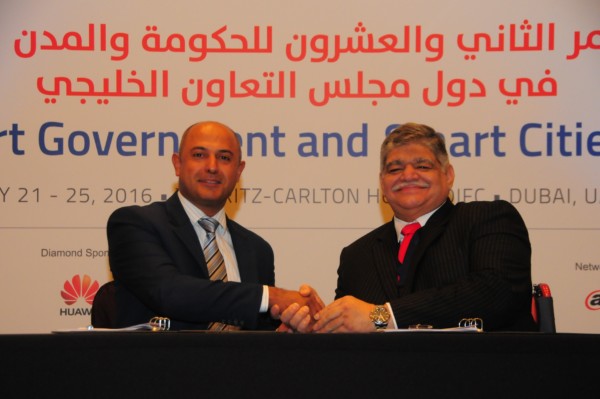
Huawei has signed a Memorandum of Understanding (MoU) with SamTech Middle East, a regional systems integrator specialising in smart vehicle tracking systems, to develop integrated solutions for the regional transport sector. The MoU will see SamTech develop customised applications that integrate with Huawei’s connected-vehicle solution to improve public safety and comfort across all forms of transport including buses, taxis and heavy goods vehicles.
The connected-in-vehicle offering is part of Huawei’s Smart City solution set and is underpinned by its ‘Leading New ICT’ initiative designed to facilitate the evolution of traditional IT architecture of enterprises into a cloud-based model. It is a combination of technologies that include cloud computing, Big Data, IoT, 5G and SDN as components of Huawei’s cloud-pipe-device strategy.
The MoU signing was held in conjunction with the 22nd GCC Smart Government and Smart Services Conference, where Huawei was conferred with the prestigious ‘Smart Solution Service Provider Excellence’ by the Middle East Excellence Awards Institute in recognition for its commitment towards driving Smart City initiatives.
Huawei’s Smart City initiative aims to deliver expertise in end-to-end network planning and the development of cutting-edge technologies including mobile broadband infrastructure and communication technology for industry applications such various connected-vehicle scenarios.
“The regional transport industry is about to make a major leap into the future, with new ICT solutions enabling increased levels of capability in safety, efficiency and comfort,” said Safder Nazir, Regional Vice President, Smart Cities and IoT, Huawei Middle East. “Huawei’s connected-in-vehicle solution coupled with SamTech’s intelligent software delivers on a key capability for regional Smart City initiatives whilst enabling critical control capability for transportation and emergency service stakeholders.”
The joint smart vehicle solution offers a variety of safety and security services such as in-vehicle video surveillance, accurate passenger tracking, emergency services communication, real-time vehicle health data analysis and even allows for a host of multi-media services for passenger’s entertainment. By enabling high-speed internet connectivity to transport vehicles, stakeholders can also access high-definition in-vehicle video surveillance to monitor driver and passenger status, analyse driver performance, highlight potential safety issues such as passengers not wearing seatbelts and even allow for swift connectivity to emergency services in the event of a road collision or accident.
“As a leading system integrator with more than 13 years of regional vehicle tracking expertise, SamTech is well positioned to provide software solutions that add value to Huawei’s widely adopted technologies,” said Samir I. Abdul Hadi, founder and CEO of SamTech Middle East. “SamTech’s innovative solutions and applications are conceived, planned and developed in Dubai to utilise state-of-the-art hardware applications in partnership with leading vendors in the Internet of Things (IoT) industry. We appreciate Huawei’s leadership in the intelligent transportation sphere and are proud to be partnering with them in the journey to revolutionise the regional transport landscape.”
The MoU with SamTech is in line with Huawei’s ‘Transforming Together 2.0’ channel strategy that is based on developing strong, collaborative partnerships to help end-users gain maximum value out of its solutions. Huawei is committed to building an ecosystem of partners to complement and provide compelling value propositions to businesses. Through insights and understanding of local market needs, Huawei’s partners play an important role in delivering sustainable market growth in the region.
Huawei recently signed an MoU with Intel to deploy Intel’s X86 microprocessors in Huawei’s IoT gateway for its Smart Bus Solution. This will provide better performance to a multitude of smart services including in-vehicle video surveillance, accurate passenger tracking, emergency services communication, real-time health data analysis of the vehicle and multi-media services for passenger entertainment.





